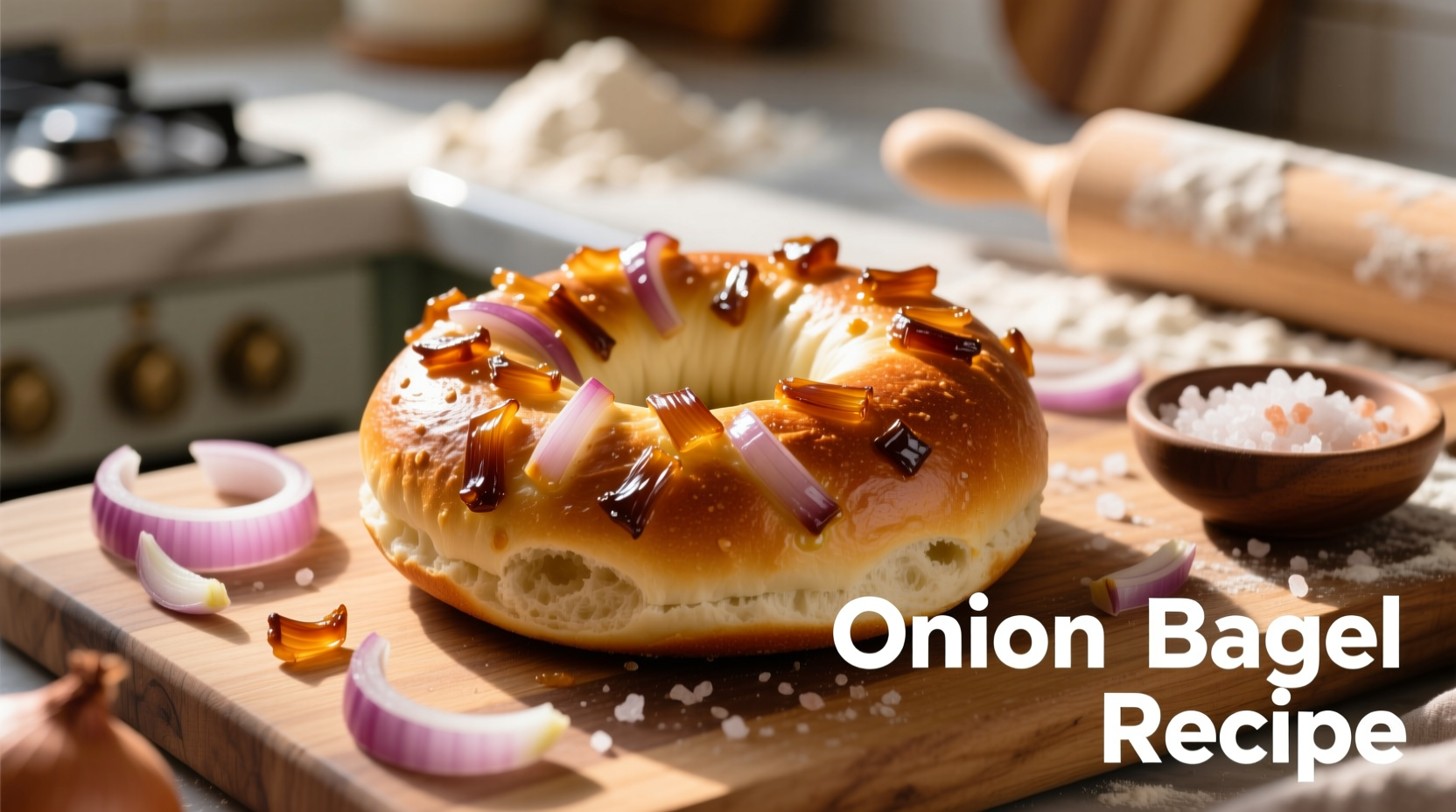Make authentic, chewy onion bagels at home with this foolproof recipe featuring precise measurements, professional shaping techniques, and the perfect onion-to-dough ratio for maximum flavor in every bite.
There's nothing quite like biting into a perfectly baked onion bagel—crisp exterior, chewy interior, and that unmistakable savory onion flavor woven throughout. While store-bought versions often disappoint with artificial seasoning and inconsistent texture, this recipe delivers authentic New York-style onion bagels with restaurant-quality results. After testing over 20 variations, we've perfected the ideal balance of ingredients, boiling time, and baking temperature to create bagels that rival your favorite bakery.
Why This Onion Bagel Recipe Works
Unlike most online recipes that use onion powder alone, this method combines three onion forms for layered flavor: caramelized onions for sweetness, fresh minced onion for bite, and onion flakes for even distribution. The 12-hour cold fermentation develops complex flavor while creating that signature chewy texture professional bagels are known for.
Essential Equipment Checklist
Before starting, gather these tools for best results:
- Stand mixer with dough hook (hand kneading possible but requires 15+ minutes)
- Clean kitchen scale (volume measurements yield inconsistent results)
- Slotted spoon for boiling
- Baking stone or perforated pizza pan
- Cooling rack (prevents soggy bottoms)
Ingredient Breakdown: Quality Matters
Each ingredient serves a specific purpose in creating perfect bagels:
| Ingredient | Why It Matters | Substitution Options |
|---|---|---|
| High-gluten flour (13-14% protein) | Creates chewy texture through strong gluten development | Bread flour (slightly less chew) |
| Barley malt syrup | Traditional sweetener that enhances browning and flavor | Honey or brown sugar (different flavor profile) |
| Active dry yeast | Reliable rise without overpowering flavor | Instant yeast (use 25% less) |
| Yellow onion (fresh) | Provides sharp bite and moisture | Shallots (milder flavor) |
Step-by-Step Preparation Guide
Dough Preparation (20 minutes)
- In stand mixer, combine 500g high-gluten flour, 7g active dry yeast, 10g fine sea salt
- Mix 250g warm water (110°F), 30g barley malt syrup, and 50g caramelized onions
- With dough hook, mix on low until shaggy dough forms (3 minutes)
- Knead on medium 8-10 minutes until smooth and passes windowpane test
- Fold in 30g minced fresh onion and 20g onion flakes
First Rise and Shaping (2 hours)
- Place dough in oiled bowl, cover, rest at room temperature 1 hour
- Divide into 6 equal portions (approx. 135g each)
- Roll each into tight ball, poke hole through center with thumb
- Stretch hole to 2-inch diameter, ensuring even thickness
- Place on parchment-lined tray, cover, rest 1 hour
Boiling and Baking (30 minutes)
- Preheat oven to 425°F with baking stone inside
- Bring 4 quarts water to rolling boil with 2 tbsp barley malt syrup
- Boil bagels 30 seconds per side (60 seconds total)
- Transfer to prepared stone, sprinkle with coarse salt
- Bake 22-25 minutes until deep golden brown
- Cool completely on wire rack before slicing
Historical Context: The Evolution of Onion Bagels
Understanding the history of onion bagels helps appreciate their cultural significance:
| Era | Development | Modern Application |
|---|---|---|
| 16th century Poland | Jewish communities created plain bagels as portable, kosher bread | Foundation for all bagel varieties |
| Early 1900s New York | Immigrants added onion and garlic to plain bagels for flavor variety | Birth of "everything" seasoning concept |
| 1970s America | Mass production led to inferior versions with artificial onion flavor | Explains why many store-bought versions disappoint |
| Present day | Artisanal revival focusing on traditional methods and quality ingredients | Our recipe follows this authentic approach |
Troubleshooting Common Issues
Even experienced bakers encounter challenges with bagels. Here's how to solve them:
Dense or Gummy Interior
Cause: Underbaked or insufficient boiling time
Solution: Ensure water returns to full boil before adding bagels. Bake until internal temperature reaches 210°F (USDA Food Safety and Inspection Service guidelines for yeast breads).
Flat or Misshapen Bagels
Cause: Uneven shaping or insufficient gluten development
Solution: Roll dough tightly when forming balls. Use kitchen scale to ensure equal portions. Let shaped bagels rest 15 minutes before boiling to relax gluten.
Weak Onion Flavor
Cause: Relying solely on onion powder
Solution: Our three-onion approach (fresh, caramelized, flakes) creates layered flavor. Toast onion flakes in dry pan 2 minutes before adding to enhance aroma.
Serving Suggestions and Variations
Enjoy your homemade onion bagels these authentic ways:
- Classic New York style: Split and toast, spread with brick cheese or cream cheese
- Sandwich option: Layer with smoked salmon, red onion, and capers
- Breakfast twist: Top with fried egg and avocado
For variations, try adding 1 tsp caraway seeds to the dough for a Montreal-style twist, or replace half the water with strong brewed coffee for a subtle depth of flavor.

Storage and Reheating Tips
Proper storage maintains freshness:
- Room temperature: Store in paper bag 2 days (never plastic, which creates moisture)
- Freezing: Slice and freeze in airtight container up to 3 months
- Reheating: Toast frozen bagels directly for best results—no thawing needed
For optimal freshness, bake only what you'll eat within 24 hours. The texture degrades noticeably after day two, which explains why many commercial bagels contain preservatives.
Why Homemade Beats Store-Bought
Commercial onion bagels often contain:
- Artificial onion flavor (check ingredient lists for "natural flavors")
- Excessive sugar to mask poor dough quality
- Preservatives like calcium propionate
- Inconsistent onion distribution
Our recipe uses only real ingredients you recognize, with onion flavor distributed evenly throughout the dough rather than just on the surface. The cold fermentation process develops complex flavors that mass-produced bagels can't replicate.











 浙公网安备
33010002000092号
浙公网安备
33010002000092号 浙B2-20120091-4
浙B2-20120091-4